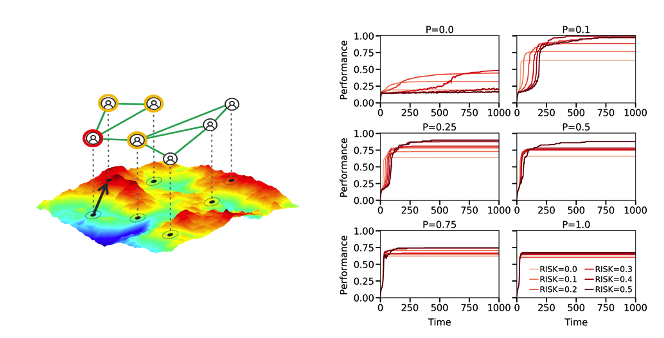Efficient Collective Problem-Solving
Military / Coalition Issue
Teamwork lies at the cornerstone of the modern workplace, allowing organizations to tackle problems whose complexity reaches beyond the abilities of individuals. Similarly, the complexity of modern military operations creates a demand for efficient collaborative decision-making and problem-solving. Since an effective operability in dynamic environments requires precise dissemination and transfer of information across the command-and-control structure, the key question remains what types of social interactions are most suitable for achieving necessary Command and Control (C2) capabilities.
Core idea and Key Achievements
Our approach is to model collaborative problem-solving and study how well groups of agents address tasks of increasing complexity. The developed simulation environment enables us to test how the structure of the social network used to share information and modes of information accumulation affect the accuracy and speed of collective work.
Key achievements include:
- Determining that the detailed structure of the social network used to share information has limited impact on the group performance and that sparsely connected teams perform equally well or better than densely connected ones.
- Showing that collective decisions are reached faster in densely connected teams, however at a cost of lower accuracy.
- Observing that intermittent switching between group work and individual work results in a significant increase in overall team performance, when compared to constant group work.
- Demonstrating that in order to solve highly complex tasks, collective problem-solving needs to incorporate a certain level of risk, which can be optimized to improve group performance.

Implications for Defence
Future C2 structures need to match the variability and dynamism of modern military operations. Our agent-based simulation techniques provide an environment for testing various C2 configurations and assessing their viability. We can also use our modelling approach to guide design of war games, which in turn can be utilized to validate and further improve the simulation.
Readiness and Alternative Defence Uses
This project is simulation driven and as such, our observations are limited by the constraints of this environment. Further progress would require human testing, in order to test overlap of theory and practice, as well as to extend simulations into more specific military scenarios.
Resources and References
- Turalska, Malgorzata, Geeth R. De Mel, Rosie Lickorish, Liam Turner, Roger Whitaker, and Dave Braines. “Optimizing the efficiency of collective decision making in groups.” In Artificial Intelligence and Machine Learning for Multi-Domain Operations Applications III, vol. 11746, p. 117460L. International Society for Optics and Photonics, 2021.
- github repository
Organisations
ARL, IBM UK, Cardiff, Southampton